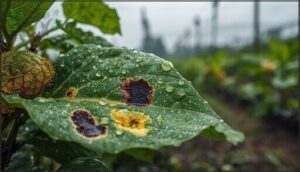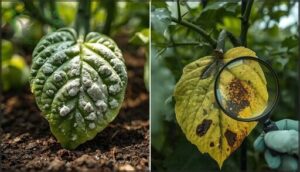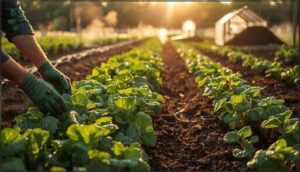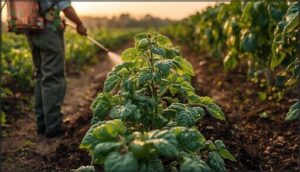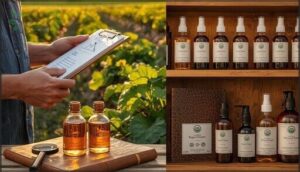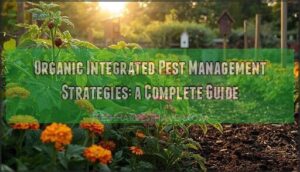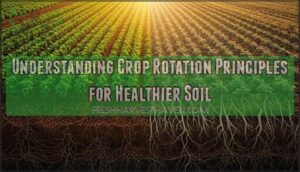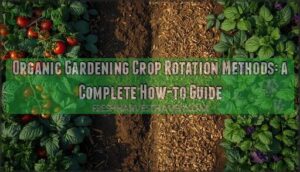This site is supported by our readers. We may earn a commission, at no cost to you, if you purchase through links.

Your tomato plants looked perfect last week, but now yellow spots crawl across the leaves and fuzzy gray patches multiply overnight. You’re watching thousands of dollars in crops slip away, and the clock is ticking.
Organic disease control doesn’t rely on synthetic chemicals to stop these losses—instead, it builds plant immunity from the soil up, using biological allies and strategic prevention to break disease cycles before they start. This approach cuts pesticide use by 80-98% while maintaining healthy yields, but success depends on understanding which pathogens you’re facing and timing your interventions precisely.
The difference between salvaging your harvest and starting over often comes down to recognizing early warning signs and knowing exactly which organic methods work for bacterial, fungal, and viral threats.
Table Of Contents
- Key Takeaways
- Principles of Organic Disease Control
- Common Plant Diseases in Organic Farming
- Preventive Strategies for Disease Management
- Organic Methods for Disease Control
- Ensuring Compliance and Effective Application
- Frequently Asked Questions (FAQs)
- What is organic disease management?
- What are the 5 principles of plant disease control?
- What is an organic fungicide?
- How much do organic treatments cost?
- When should organic fungicides be applied?
- Can organic methods work in greenhouses?
- How long do organic treatments last?
- What organic certification requirements exist?
- How much do organic disease control products cost?
- Can organic methods work in greenhouse settings?
- Conclusion
Key Takeaways
- Organic disease control reduces pesticide use by 80-98% by building plant immunity through soil health, beneficial microbes, and strategic prevention rather than reacting with synthetic chemicals after symptoms appear
- Success depends on recognizing which pathogen type you’re facing—bacterial diseases show water-soaked lesions and ooze, fungal infections create powdery coatings and wilting, while viral diseases cause mosaic patterns and leaf curling that spread rapidly through insects
- Prevention strategies like 3-4 year crop rotations cut disease by 20-30%, compost applications suppress over 50% of diseases through microbial activity, and immediate removal of infected plants reduces pathogen loads by up to 80%
- Effective organic treatment requires precise timing of OMRI-listed products during early infection windows, field scouting every 3-7 days to catch diseases at 1-5% infection thresholds, and meticulous record-keeping to maintain USDA organic certification compliance
Principles of Organic Disease Control
Organic disease control starts with a mindset shift—you’re building plant health from the ground up rather than reacting to problems after they appear. This approach relies on prevention, natural immunity, and working with the environment instead of against it.
Understanding these core principles helps you see why organic methods work differently, how they fit into sustainable farming, and what makes them effective long-term.
Core Concepts and Preventive Focus
Think of organic disease management as building a fortress before invaders arrive. You focus on disease prevention by strengthening plant immunity and creating conditions where pathogens can’t thrive.
These sustainable methods prioritize biological control and plant health and protection over reactive treatments. By applying organic principles and eco-friendly practices, you eliminate disease triggers before symptoms ever appear—making your farm naturally resilient.
Effective organic farming often relies on traditional practices to maintain a healthy balance.
Differences From Chemical-Based Methods
The gap between chemical-based methods and organic disease management comes down to environmental impact and toxicity levels. You’ll maintain ecological balance through biological control and sustainable practices instead of applying synthetic compounds.
While chemical alternatives disrupt soil life and create resistant pathogens, disease control in organic farming strengthens your farm’s natural defenses—reducing pesticide use by 80–98% in crops like carrots. This approach aligns with organic farming practices that prioritize ecosystem health.
Role in Sustainable Agriculture
Organic disease management is at the heart of sustainable agriculture, building resilient ecosystems that weather climate extremes while protecting both land and people. Your commitment to environmental stewardship through eco-friendly farming pays off: organic systems cut energy use by 32% and slash eutrophication potential nearly in half compared to conventional operations, all while supporting green agriculture that strengthens natural pest defenses.
Organic disease management builds resilient ecosystems that cut energy use by 32% while protecting both land and people from climate extremes
- Climate resilience through soil health management: Organic systems produce 31% higher yields during drought by fostering disease-suppressive soils
- Enhanced profitability despite challenges: You’ll save 22–35% on inputs while earning organic premiums, offsetting occasional disease losses
- Measurable pollution reduction: Regions with more organic acreage show lower fungicide contamination in waterways
- Worker safety improvements: Integrated pest management in organic ecosystems reduces occupational exposure to toxic disease-control chemicals by 27%
- Biodiversity that works for you: Sustainable practices increase beneficial organisms that naturally suppress pathogens without synthetic interventions
Common Plant Diseases in Organic Farming
You’ll run into three main types of diseases when managing an organic farm: bacterial, fungal, and viral. Each one shows up differently on your plants and requires its own approach to control.
Let’s look at what you’re dealing with and how to spot the warning signs early.
Bacterial Diseases and Their Symptoms
Bacterial leaf spot strikes when water-soaked lesions appear on leaves, often spreading to stems and fruit. These bacterial infections—including speck, canker, and soft rot—can damage 10–30% of plants in humid weather.
You’ll notice ooze, rapid necrosis, and wilting as key signs. Strong plant immunity and disease resistance are your first line of defense, with biological control and organic remedies supporting disease management when prevention alone isn’t enough.
Fungal Diseases and Their Symptoms
Fungal infections—downy mildew, powdery mildew, grey mold, and fusarium wilt—drive substantial losses in organic systems, particularly where soil fungi and plant pathogens thrive in amended soils high in organic carbon.
You’ll recognize these diseases by:
- White powdery coatings or fuzzy grey growth on leaves and fruit
- Yellowing, wilting, and sudden vascular collapse from root to stem
- Dark lesions, leaf spots, and fruit rot under humid conditions
Effective disease control requires fungicide alternatives and vigilant monitoring.
Viral Diseases and Their Symptoms
Plant viruses—including cucumber mosaic, tomato yellow leaf curl, and citrus greening (Huanglongbing)—cost growers roughly $30 billion yearly and spread rapidly through aphids and whiteflies, making epidemic management critical.
You’ll spot virus transmission effects as mosaic patterns, leaf curling, stunting, and chlorosis. Accurate disease diagnosis of these symptom patterns allows you to act fast, removing infected plants before disease control efforts become overwhelming.
Preventive Strategies for Disease Management
Prevention is where real disease control happens on an organic farm. You can’t spray your way out of every problem, so building a system that stops diseases before they start saves you time, money, and stress.
The strategies below form the foundation of a healthy farm that naturally resists disease pressure.
Crop Rotation and Plant Diversity
Breaking the cycle of disease starts with smart rotation. When you switch crops every 3–4 years, you cut disease incidence by 20–30% and starve pathogens of their hosts. Here’s how rotation benefits your fields:
- Extend sequences to at least three years for maximum disease suppression
- Diversify crop families to interrupt pathogen life cycles
- Include non-host crops like corn or sorghum before susceptible plants
- Boost plant diversity through intercropping to reduce soilborne disease by 55%
Soil Health and Compost Use
Think of your soil as a living fortress—compost builds its defenses. Mature compost suppresses diseases in over 50% of tested cases by boosting microbial activity and fungal diversity, while increasing organic matter above 6% creates stable disease suppression.
You’ll see tenfold increases in beneficial microbes and better moisture retention, transforming your soil into a pathogen-fighting powerhouse that outperforms chemical approaches.
Sanitation and Removal of Infected Plants
Removing diseased plants immediately isn’t just cleanup—it’s cutting off the enemy’s supply line. Field sanitation reduces pathogen loads by up to 80%, delaying outbreaks by weeks and slashing spread in adjacent rows by 30–50%.
Your disease prevention action plan:
- Uproot infected plants entirely (roots included) the moment symptoms appear
- Disinfect tools between cuts to stop spreading fungal, bacterial, or viral pathogens
- Bag diseased debris and remove it from production areas—don’t compost unless temperatures exceed 68°C for 20+ days
- Clean greenhouse surfaces weekly to eliminate spores lurking on benches and walkways
These sanitation methods and crop hygiene practices form your frontline defense in plant disease control.
Selecting Disease-Resistant Varieties
Choose varieties like they’re your insurance policy—resistance bred into the seed pays off season after season. Resistant crop breeding cuts yield losses by up to 20% in major crops, and disease-resistant cultivars reduce fungicide needs by half.
Look for breeding programs that target your region’s toughest diseases. In wheat, disease resistance boosts margins by nearly €5 per hectare annually, proving genetic resistance beats spraying.
Organic Methods for Disease Control
When prevention alone isn’t enough, you’ll need effective organic tools to manage disease outbreaks on your farm. The good news is that organic disease control offers several practical approaches, from living organisms that fight pathogens to carefully timed physical interventions.
Let’s look at the specific methods you can use to keep your crops healthy without compromising your organic certification.
Biological Control Agents and Beneficial Organisms
You can employ microbial ecology to fight plant diseases naturally. Beneficial insects and natural predators work alongside soil microbes like Trichoderma and Bacillus—powerful fungal antagonists that suppress pathogens while boosting plant growth.
These biological control agents offer proven biocontrol methods, often cutting disease by 40–80% in field conditions. They’re your front-line defense, providing microbial control that protects crops without synthetic inputs.
Organic-Approved Sprays and Treatments
Beyond beneficial organisms, you’ll sometimes need direct intervention with organic sprays and treatments. Copper fungicides and sulfur products anchor organic disease management—field trials show sulfur cutting powdery mildew by over 80%.
Bicarbonate sprays, horticultural oils, and biopesticide formulations like Trichoderma give you additional natural fungicides. These organic amendments work best when timed right, keeping disease control in organic farming effective without synthetic residues.
Physical and Cultural Practices
While sprays have their place, your most powerful defense builds on simple physical interventions and smart field practices. Mulching benefits extend beyond weed control—organic mulch reduced litchi downy blight by up to 86% while boosting beneficial fungi.
Pair these soil management tactics with strategic pruning techniques and irrigation control:
- Prune infected shoots during dry weather to cut inoculum spread
- Space plants wider and thin canopies to lower humidity
- Schedule morning irrigation so foliage dries quickly
- Use crop rotation with non-hosts to suppress soilborne diseases
These integrated pest management strategies reshape your farm’s microclimate, making it hostile to pathogens while strengthening cover crops and overall soil health through proven organic farming practices.
Companion Planting and Habitat Conservation
You’ll boost cultural controls when you pair vegetables or row crops with strategic companion planting and habitat diversification. A 2024 synthesis showed species-rich schemes cut crop damage by 23% while boosting natural predators by 44%—direct proof that biodiversity conservation and plant symbiosis work.
Maintain field edges with cover crops and non-crop refugia to strengthen soil ecosystems, support beneficial insects, and restore ecological balance across your organic gardening system.
Ensuring Compliance and Effective Application
You can’t just throw organic treatments at your plants and hope for the best—compliance and timing matter just as much as choosing the right product. The difference between success and failure often comes down to following regulations, keeping solid records, and adjusting your approach based on what you see in the field.
Here’s what you need to focus on to make your organic disease control both effective and certifiable.
Choosing NOP-Compliant Inputs
Finding the right input materials for organic disease management means you’ll need to confirm every product meets NOP regulatory frameworks. Here’s how to stay compliant:
- Check organic labels for OMRI listings or WSDA registration to verify each active ingredient and inert component passes compliance checks
- Review your organic system plan to guarantee material reviews document all disease-control inputs before field use
- Confirm botanical and microbial products meet National List standards through manufacturer records or third-party certification
This groundwork keeps your organic farming practices audit-ready.
Application Timing and Techniques
Precise timing strategies will make or break your organic disease management results. Start fungicide applications at early disease-risk windows—when weather models forecast infection periods—rather than waiting for visible symptoms.
Use disease forecasting tools to schedule spray intervals between seven and fourteen days, adjusting based on rainfall and humidity.
Verify spray coverage reaches both leaf surfaces with 100 to 150 gallons per acre, because incomplete coverage undermines even perfectly timed biological control methods.
Record Keeping and Certification Standards
Your Organic System Plan must document every input, from Trichoderma treatments to copper sprays, ensuring full traceability for USDA NOP compliance audits.
Keep pesticide application records for five years minimum—including OMRI-listed product labels and manufacturer confirmations—to satisfy certification requirements.
Digital traceability systems simplify regulatory standards verification, helping you reconcile quantities during mass-balance reviews and demonstrate that your organic farming practices align with the certification process.
Monitoring and Adjusting Control Strategies
You can’t control what you can’t see—that’s why field scouting every 3 to 7 days during high-risk periods catches diseases early. Combine sensor technology with weather forecasting and disease modeling to time your biological control methods precisely.
When disease management monitoring shows infection hitting 1 to 5% of plants, action thresholds trigger your pest control strategies, reducing unnecessary applications by up to 50% while keeping disease forecasting sharp.
Frequently Asked Questions (FAQs)
What is organic disease management?
You’ll prevent and suppress plant diseases by combining ecological, cultural, biological, and physical methods that comply with organic standards—prioritizing soil health, crop diversity, and beneficial organisms over synthetic pesticides.
What are the 5 principles of plant disease control?
When managing crops, you’ll rely on five core disease control methods: exclusion techniques block pathogens, eradication removes infected material, avoidance adjusts timing, protection applies treatments, and resistance breeding selects tolerant varieties.
What is an organic fungicide?
You can use fungicides made from natural compounds like copper, sulfur, or plant oils instead of synthetic chemicals.
Microbial controls and biological sprays help protect your crops while keeping your organic certification intact.
How much do organic treatments cost?
Regarding budget planning, organic disease control won’t break the bank. Applications range from $5 to $23 per acre, making expense management practical for most operations while supporting sustainable organic farming practices.
When should organic fungicides be applied?
You’ll get the best disease control by timing natural fungicides before infection occurs, watching weather forecasting closely, and applying during critical crop stage windows when spray timing aligns with disease thresholds and favorable conditions.
Can organic methods work in greenhouses?
Yes, you can hit the ground running with organic disease management in greenhouses. Biological controls and organic fungicides deliver 70–99% disease reduction in controlled environments, while soil microbes and integrated systems maintain healthy crops without synthetic pesticides.
How long do organic treatments last?
Organic fungicides require reapplication every 7 to 14 days as residues degrade quickly.
Biological controls offer variable persistence, lasting days to weeks.
Compost tea delivers peak disease suppression within 24 to 48 hours, demanding frequent renewal for sustained protection.
What organic certification requirements exist?
You’ll need to maintain an Organic System Plan approved by a USDA-accredited certifier, document all disease-control inputs against NOP Standards, and verify OMRI-listed products meet Organic Compliance before application to satisfy Accreditation Requirements under the Regulatory Framework.
How much do organic disease control products cost?
Prices swing widely depending on what you’re buying—neem oil runs $15–25 per bottle, while commercial biofungicides can hit $350 or more, and per-acre costs range from $200 to over $900 annually.
Can organic methods work in greenhouse settings?
Greenhouses offer an ideal setting for organic disease management. The controlled environment enhances biological controls, fosters precise climate management, and facilitates proactive greenhouse sanitation.
Soil remediation, organic pesticides, and sustainable agricultural practices deliver measurable disease suppression in confined spaces.
Conclusion
A California tomato grower slashed late blight losses from 40% to under 5% by rotating crops, applying copper sprays at first symptom, and introducing Bacillus subtilis as a soil guardian. That shift didn’t happen by accident—it required daily scouting, precise timing, and relentless commitment to prevention.
Your success with organic disease control hinges on the same formula: catch threats early, deploy the right biological tools, and never let your guard down when plants signal distress.

